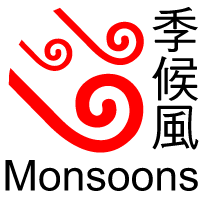Strong Monsoon Signal
 |
The Strong Monsoon SignalThe Strong Monsoon Signal is issued when winds associated with the summer or winter monsoon are blowing in excess of or are expected to exceed 40 kilometres per hour near sea level anywhere in Hong Kong. Winter monsoon normally blows from the north or from the east while summer monsoon typically blows from the southwest. In very exposed places, monsoon winds may exceed 70 kilometres per hour. |
Monsoons
Monsoons are large-scale wind systems caused by differences in the temperatures of land and sea over the seasons.
In winter, the continental land mass cools off rapidly, resulting in very low temperatures over central Asia. As cold air accumulates, pressure rises and a huge continental anticyclone develops over Siberia with the Tibetan Plateau forming an effective barrier blocking the southward spread of cold air from the anticyclone. From time to time, under the influence of upper air disturbances, cold air from this anticyclone plunges southward through China and brings outbursts of cold air to the south China coastal areas. Depending on the time of the season, and the juxtaposition of various weather systems, these surges will arrive in Hong Kong as northerlies, northeasterlies or easterlies.
In summer, intense solar heating leads to scorching temperatures over the Asian land masses. As a result, the overlying air heats up, expands and rises upwards. This leads to the formation of a semi-permanent low pressure area near the heart of the continent. Warm and moist air from the Indian Ocean and the South China Sea flowing into this low pressure area is experienced as the summer monsoon over south and southeast Asia.
Winds associated with the monsoons are generally more persistent than those brought by tropical cyclones and may last for days. In intense surges of the winter monsoon, northeasterlies of up to gale force are not uncommon over the south China coastal waters. However, the full impact of these winds is not always felt in Hong Kong, particularly in heavily built-up areas or where nearby terrain provides some sheltering.
Occasionally, in winter, tropical cyclones traversing the South China Sea pass to the south of Hong Kong just when a monsoon is affecting the coastal areas of south China. Winds in Hong Kong are greatly enhanced due to the very large pressure difference between the continental anticyclone and the centre of the tropical cyclone.
Points to note
- When the Strong Monsoon Signal is in force, the announcement is always accompanied by an indication of the direction from which winds are expected to blow. It is important to take note of this wind direction and you should be aware that local topography, or, the presence of buildings nearby sometimes modifies the airflow substantially, making it exceptionally gusty in very localised areas.
- If you are not well sheltered from the monsoon, precautions should be taken against strong gusty winds. Flower pots and other objects likely to be blown away should be taken indoors. Engineers, architects and contractors should ensure that all scaffoldings, hoardings and temporary structures are secured.
- If necessary, owners of small craft should make arrangements for the safety of their boats and make sure that all deck fittings are firmly fastened.
- Those engaging in water sports or operations at sea should take special care against high winds and rough sea conditions. Rough seas and swells may affect the coast. You should beware of the risk and stay away from the shoreline for safety sake.
- Drivers using highways and flyovers should be particularly alert to strong gusts.
- You should take note of the latest weather information and related announcements broadcast on radio and TV and given in the Observatory's Internet websites viz. https://www.weather.gov.hk and https://www.hko.gov.hk